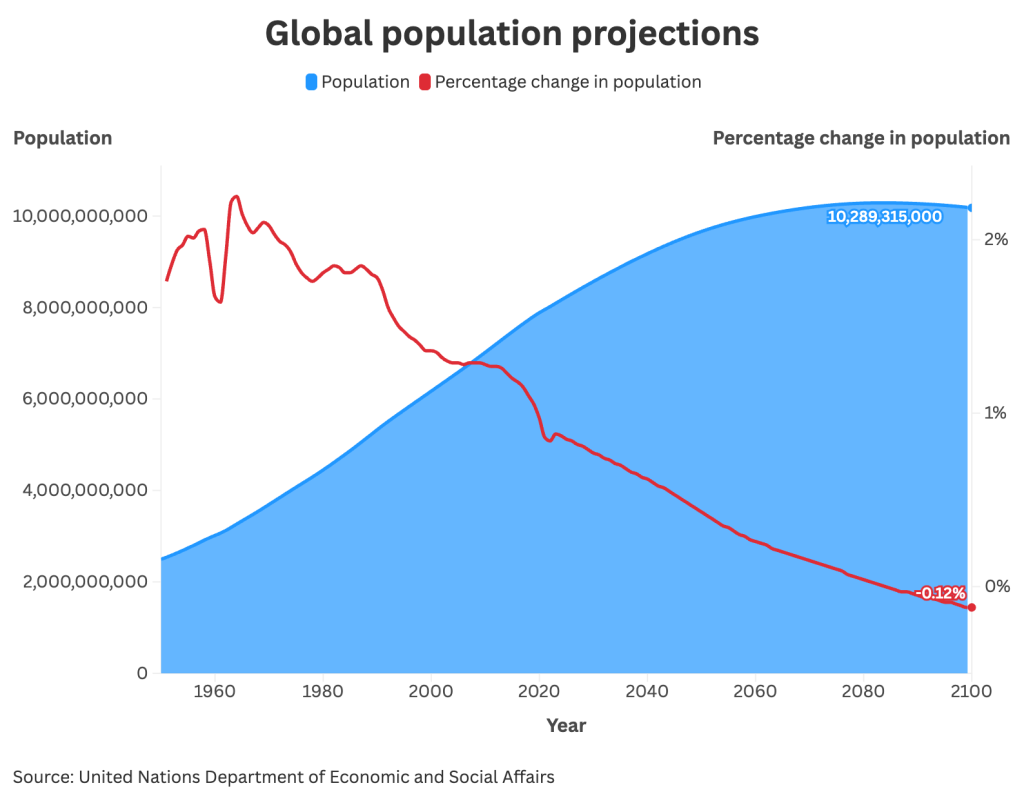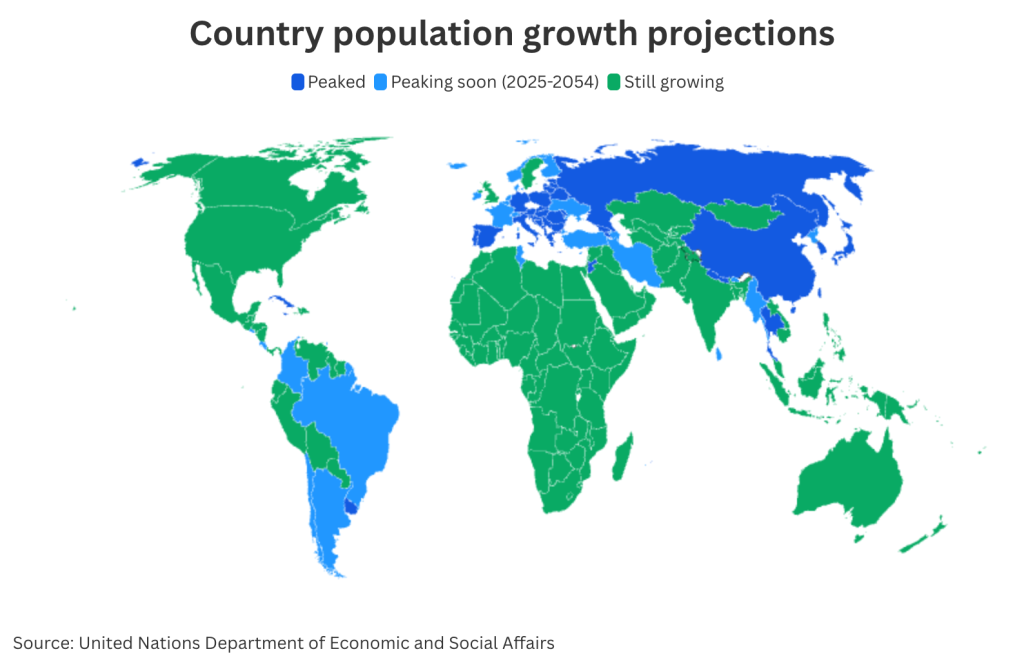
The great population peak: What happens after 10.3B?
The great population peak: What happens after 10.3B?
In 1968, biologist Paul Ehrlich’s “The Population Bomb” warned of a looming catastrophe: famines and societal collapse driven by runaway population growth. Over five decades later, the global conversation has reversed. Instead of overpopulation, today’s greatest demographic concern is decline. According to the United Nations, the world population is now expected to peak in the mid-2080s at around 10.3 billion before gently declining to 10.2 billion by 2100. This shift marks one of the most consequential transitions in human history, with vast implications for economies, labor markets, and public services.
The great demographic reversal
Fertility rates have dropped dramatically across the globe, from 5.3 children per woman in 1963 to 2.2 in 2023. This data feature from Vital Records Index NYC explores the latest population projections, the countries experiencing peak and decline, and the economic shocks that may follow.
The numbers tell the story: Global population projections
From 2.6 billion people in 1950 to 8.2 billion in 2024, humanity has grown at a pace never before seen. But projections from the UN now estimate an 80% probability that this growth will reverse by century’s end, up from a 30% estimate in 2013.
Instead of continuing upward, the global population is forecasted to peak at 10.3 billion around the 2080s, then begin a slow decline to 10.2 billion by 2100 — a drop of 700 million compared to previous projections.
Much of this change is due to falling fertility rates. As of 2024, the global fertility rate sits at 2.1 — just at replacement level — down from over 5 in the 1960s. More than half of all countries now fall below this threshold. Factors such as rising urbanization, expanding access to education (especially for women, and economic development are driving this demographic transformation.

A tale of 3 demographics: Countries at different stages

Countries that have already peaked include China, Germany, Japan, and Russia, all of which are projected to see population declines of up to 14% over the next 30 years. Other steep decliners include Lithuania, Bosnia and Herzegovina, and Albania.
Countries approaching peak like Brazil, Iran, Turkey, and Vietnam are expected to reach their population zeniths between 2025 and 2054. These nations may see moderate growth — around 5.3% — before experiencing a downward trend.
Still-growing nations are mostly concentrated in Africa and South Asia, including India, Indonesia, Nigeria, Pakistan, and the United States. These countries are projected to grow by 38% through 2054. Sub-Saharan Africa is poised to account for 54% of global births by 2100, up from 29% in 2021. The region maintains high fertility rates (around four births per woman), with countries like Angola, Niger, and the Central African Republic expected to double their populations by mid-century.
Economic shockwaves: The cost of demographic change
The aging crisis looms large in developed nations. By 2080, the number of people aged 65 and over will surpass the population under 18. Japan already serves as a cautionary tale; its GDP growth dropped from 4% in the 1980s to less than 1% by 2019, partly due to workforce shrinkage.
Pension systems are under strain. Many countries are shifting from a 10:1 worker-to-retiree ratio to as few as 3:1. In some places, up to 50% of labor income may need to be redirected to support aging populations.
Labor market disruptions are also on the rise. Shrinking working-age populations mean shortages in critical sectors like health care and education. Tax burdens on younger workers will likely increase unless productivity compensates.
The implications for economic growth are sobering. Automation and immigration offer stopgap solutions. The UN reports that immigration is projected to be the main population driver in 52 countries by 2054.
Policy responses and future implications
Pro-natalist policies are proliferating; a number of countries have incentives to encourage childbirth, such as Singapore, which offers baby bonuses, while France and Sweden provide generous family support systems.
Technology and automation offer short-term relief. Countries are investing in AI and robotics to offset labor shortages. However, tech can’t replace the creativity, empathy, or innovation of a robust human workforce.
Countries grappling with demographic pressures are reconsidering immigration reforms. For many, immigration remains the most viable lever for maintaining growth and sustaining social safety nets.
Long-term solutions require lifelong learning, gender equity, and welfare reform. Reskilling older workers, investing in childcare, and supporting dual-income households are strategies that could soften the demographic blow.
Conclusion: Navigating the demographic transition
Paul Ehrlich’s grim forecasts in “The Population Bomb” never came to pass, but his influence lingers. Today, the world faces a different challenge: navigating the consequences of population stagnation and decline. Unlike the doomsday visions of the 20th century, the threats ahead will not come from scarcity, but from imbalance.
The global population peak marks the end of an era of exponential growth that began around 1800. What comes next will test the resilience and adaptability of economies, governments, and societies.
As UN official Li Junhua put it: “The demographic landscape has evolved greatly in recent years.” . The choices leaders make now — on immigration, automation, social protections, and gender equity — will define the next century.
This isn’t a time for panic; it’s a time for policy.
This story was produced by Vital Records Index NYC and reviewed and distributed by Stacker.



